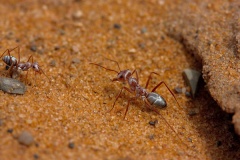Last year, I wrote about how some ants can find their way home after finding food. They have the remarkable ability to account for all the twists and turns they made while foraging and calculate a direct path leading straight back to their nest. A reader emailed to ask if I thought humans would ever be able to do something similar or to achieve the level of co-ordination shown by ants. This post is based on my reply, where I pointed out several things that humans are amazingly good at doing — in fact, we do them so well and with such ease that you might be surprised by how difficult they actually are! I’ve spent a lot of time on Inspiring Science talking about behaviours and abilities which show that other animals aren’t just simple automata because I think it’s important to make the point that although humans are unique, we aren’t special; we’re just another species with our own particular tricks for surviving in this world. I’ll take a different tack in this post and talk about some of the ways we stand out! Continue reading
How are humans like ants?
15 Wednesday May 2013
Posted in Complex systems, Humans, Language, Mind




You must be logged in to post a comment.